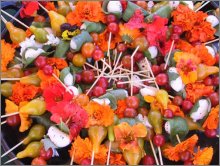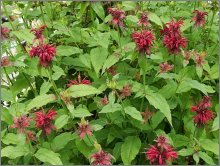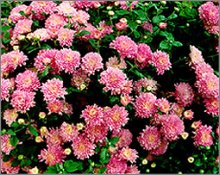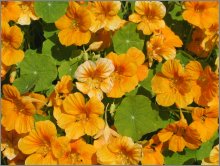|
|

|

Edible Flowers: 20 of the Tastiest and Most Versatile
by www.SixWise.com Flowers have been used as a delicate food among many cultures
for thousands of years. Romans commonly used violets in their
dishes, Hispanic cultures ate stuffed squash blossoms, Asian
Indians used rose petals, and the French liqueur Chartreuse
contains carnation petals.
|

Edible flowers are gaining popularity in restaurants,
but you can use them at home, too.
|
Today, edible flowers are usually reserved for chic restaurants
and wedding cakes, not your typical meal at home. But, edible
flowers can be quite tasty, and they make a welcome addition
raw in salads, cooked with an appetizer or main course, infused
into sauces or added to desserts.
Because edible flowers are so delicate, they don't keep well
in the refrigerator (if you must store them, put them between
two moist paper towels, wrap the package in plastic wrap,
the put it in the fridge). Instead, they're best cooked as
soon as you get them home, after carefully rinsing them in
cold water.
Edible flowers can be found at gourmet food shops, specialty
markets and farmers' markets (or in your own backyard, if
you grow them). You should not eat flowers from a florist
or that you pick on the side of the road, as they may have
been treated with pesticides
(nor should you eat flowers you've grown if you've treated
them with pesticides). Generally speaking, only the petals
of the flower (not the stems, pistil or leaves) should be
eaten (and avoid eating flowers if you have allergies, as
they could aggravate your symptoms).
If, like many Americans, you're not sure where to start when
it comes to edible flowers, here's a great primer of 20 tasty,
edible flowers you can incorporate into your meals.
|

Bee Balm petals taste like oregano and mint, and make
a great substitute for oregano in many dishes.
|
-
Bee Balm: Has a taste similar to oregano and mint,
with slight citrus undertones. Excellent for dishes that
use oregano, or in fruit and vegetable salads.
-
Calendula (Marigolds): A spicy, peppery flavor
that turns foods a golden color. Also known as "Poor
Man's Saffron" because of their flavor. Use them
in soups, pasta, herb-butters, rice dishes or salads,
or even try them in scrambled eggs.
-
Carnation: A clove-like flavor, with a spicy/sweet
kick. They can be steeped in wine or candy, or used to
decorate baked goods.
|

Chrysanthemum petals should be blanched before using,
then add a slightly bitter flavor to salads.
|
-
Chrysanthemum: A pungent, slightly bitter flavor,
similar to mild cauliflower. These petals should be blanched
before using, then make great salad toppers or stir-fry
additions.
-
Dandelion: Best when picked young, dandelions
have a sweet, honey flavor. They can be made into a potent
wine, eaten steamed with rice, or served raw over a salad.
-
Hibiscus: A flavor similar to cranberry and citrus,
the petals are slightly acidic. They can be used in salads
or boiled to make a tea.
-
Lilac: A pungent, lemon-like flavor with a strong
perfume and floral taste. Excellent in salads.
|

Nasturtiums, one of the most common edible flowers,
have a sweet, peppery flavor similar to watercress.
|
-
Nasturtium: One of the most common edible flowers,
they have a sweet, spicy, peppery flavor similar to watercress.
The flowers can be used on sandwiches, appetizers or salads,
or can be stuffed. Pickled nasturtium seedpods are often
used as an inexpensive alternative to capers.
-
Pansy: A mild, grassy, sweet flavor. Excellent
for garnishes and added to fruit or vegetable salads,
desserts and soups.
-
Queen Anne's Lace: A mild, carrot-like flavor
that's best used in salads.
-
Radish Flowers: A spicy, radish-like flavor that
makes an excellent salad topper.
-
Roses: The flavor is subtle, but similar to green
apples and strawberries with fruity, spicy or minty undertones
(darker varieties have stronger flavors). Use them in
desserts or salads, syrups and jellies, or to make flavored
punches or butters. (For an impressive display, try freezing
them in ice cube trays and serving the cubes in a punch.)
-
Snap Dragon: With flavors ranging from bland to
bitter, depending on variety, try them sparingly on salads
or as a garnish.
-
Squash Blossoms: The blossoms from squash and
pumpkin have a flavor similar to raw squash and are often
served breaded and fried, or stuffed whole.
|

Violets have a sweet, fragrant flavor and can be
used in salads, desserts and punches.
|
-
Sunflower: The petals have a slightly bitter flavor
and should be blanched before eating, then are great on
salads. The sunflower bud has a flavor similar to an artichoke,
and can be steamed.
-
Sweet Woodruff: A sweet and grassy flavor with
nutty, vanilla undertones. Use them in appetizers, soups,
stews and salads.
-
Thyme Flowers: The flowers taste like a mild version
of the herb and can be used anywhere thyme would be, such
as in soups, stews and on vegetables.
-
Tulip: A sweet, cucumber-like flavor that's excellent
on salads. (Only the petals, NOT the bulbs, are edible.)
-
Violet: A sweet, fragrant flavor that works well
on salads. Also great for garnishes, desserts and punches.
-
Yucca Flower: A crunchy texture and sweet taste
similar to an artichoke. Use them in salads and as a garnish.
Recommended Reading
Flower
Power: What Each of the 20 Most Popular Flowers Symbolize
& Other Interesting Facts
Witch
Hazel: Unnerving Name, Fantastic Health Benefits to You ...
and an Interesting Background
Sources
Edible
Flowers History
WhatsCookingAmerica.net
Home
Cooking: Edible Flowers
Starchefs.com
To get more information about this and other highly important topics, sign up for your free subscription to our weekly SixWise.com "Be Safe, Live Long & Prosper" e-newsletter.
With every issue of the free SixWise.com newsletter, you’ll get access to the insights, products, services, and more that can truly improve your well-being, peace of mind, and therefore your life!
|
|
|
|